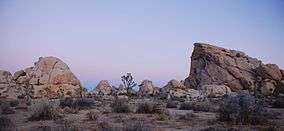Joshua Tree National Park
| Joshua Tree National Park | |
|---|---|
|
IUCN category II (national park) | |
|
Joshua Tree National Park: Cyclops and Pee Wee Formations near Hidden Valley Campground at sunrise. | |
  | |
| Location | Riverside County and San Bernardino County, California, United States |
| Nearest city | Twentynine Palms, San Bernardino |
| Coordinates | 33°47′18″N 115°53′54″W / 33.7883944°N 115.8982222°WCoordinates: 33°47′18″N 115°53′54″W / 33.7883944°N 115.8982222°W |
| Area | 790,636 acres (319,959 ha)[1] |
| Established | 31 October 1994 |
| Visitors | 1,383,340 (in 2013)[2] |
| Governing body | National Park Service |
| Website | Joshua Tree National Park |
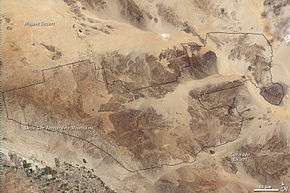
Joshua Tree National Park is located in southeastern California. Declared a U.S. National Park in 1994 when the U.S. Congress passed the California Desert Protection Act (Public Law 103-433), it had previously been a U.S. National Monument since 1936. It is named for the Joshua trees (Yucca brevifolia) native to the park. It covers a land area of 790,636 acres (1,235.37 sq mi; 3,199.59 km2)[1] – an area slightly larger than the state of Rhode Island. A large part of the park, some 429,690 acres (173,890 ha), is a designated wilderness area. Straddling the San Bernardino County/Riverside County border, the park includes parts of two deserts, each an ecosystem whose characteristics are determined primarily by elevation: the higher Mojave Desert and lower Colorado Desert. The Little San Bernardino Mountains run through the southwest edge of the park.[3]
History
The park was initially created as a National Monument on 10 August 1936, containing 825,000 acres (334,000 ha), after Minerva Hoyt led activism aimed at persuading the state and federal governments at protecting the area.[4] The park was elevated to a National Park on 31 October 1994 by the Desert Protection Act, which also added 234,000 acres to the park.[5]
Geography and botany
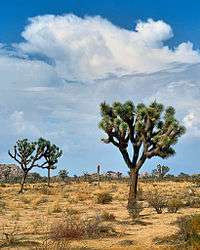
Mojave Desert
The higher and cooler Mojave Desert is the special habitat of Yucca brevifolia, the Joshua tree for which the park is named. It occurs in patterns from dense forests to distantly spaced specimens. In addition to Joshua tree forests, the western part of the park includes some of the most interesting geologic displays found in California's deserts. The dominant geologic features of this landscape are hills of bare rock, usually broken up into loose boulders. These hills are popular amongst rock climbing and scrambling enthusiasts. The flatland between these hills is sparsely forested with Joshua trees. Together with the boulder piles and Skull Rock, the trees make the landscape otherworldly. Temperatures are most comfortable in the spring and fall, with an average high/low of 85 and 50 °F (29 and 10 °C) respectively. Winter brings cooler days, around 60 °F (16 °C), and freezing nights. It occasionally snows at higher elevations. Summers are hot, over 100 °F (38 °C) during the day and not cooling much below 75 °F (24 °C) until the early hours of the morning.[6]
Joshua trees dominate the open spaces of the park, but in among the rock outcroppings are piñon pine, California juniper (Juniperus californica), Quercus turbinella (desert scrub oak), Quercus john-tuckeri (Tucker's oak), and Quercus cornelius-mulleri (Muller's oak).[7] These communities are under some stress, however, as the climate was wetter until the 1930s, with the same hot and dry conditions that provoked the Dust Bowl affecting the local climate. These cycles were nothing new, but the original vegetation did not prosper when wetter cycles returned. The difference may have been human development. Cattle grazing took out some of the natural cover and made it less resistant to the changes. But the bigger problem seems to be invasive species, such as cheatgrass, which during wetter periods fill in below and among the pines and oak. In drier times, they die back, but do not quickly decompose. This makes wildfires hotter and more destructive, which kills some of the trees that would have otherwise survived. When the area regenerates, these non-native grasses form a thick layer of turf that makes it harder for the pine and oak seedlings to get a roothold.
Colorado Desert
Below 3,000 feet (910 m), the Colorado Desert encompasses the eastern part of the park and features habitats of Creosote bush scrub, Ocotillo, desert Saltbush and mixed scrub including Yucca and Cholla cactus (Cylindropuntia bigelovii). There are areas of such cactus density they appear as natural gardens. The lower Coachella Valley is on the southeastern side of the Park with sandy soil grasslands and desert dunes.
The only palm native to California, the California Fan Palm (Washingtonia filifera), occurs naturally in five oases in the park, rare areas where water occurs naturally year round and all forms of wildlife abound.[3]
Geology
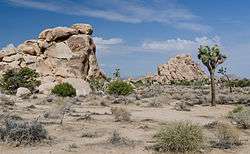
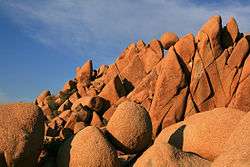
.jpg)

The rock formations of Joshua Tree National Park were formed more than 100 million years ago from the cooling of magma beneath the surface into monzogranite, with roughly rectangular joints. Groundwater then filtered through the joints to erode away the corners and edges to create rounded stones, and flash floods washed away covering ground to create piles of boulders.[8] These prominent outcrops are known as inselbergs.[9]
Recreation
Camping
Nine established campgrounds exist in the park, three of which (Black Rock Campground, Indian Cove Campground, and Cottonwood Campground) provide water and flush toilets. A fee is charged per night for each camping spot.[10] Reservations are accepted at Black Rock Campground and Indian Cove Campground for October through May, while the other campgrounds are first-come, first-served. Backcountry camping, for those who wish to backpack, is permitted with a few regulations.[11]
Hiking
There are several hiking trails within the park, many of which can be accessed from a campground. Shorter trails, such as the one mile hike through Hidden Valley, offer a chance to view the beauty of the park without straying too far into the desert. A section of the California Riding and Hiking Trail meanders for 35 miles (56 km) through the western side of the park.[12] The lookout point at Keys View, towards the south of the park, offers views of the Coachella Valley and Salton Sea.
Nature walks inside the park include:
- Hidden Valley
- Indian Cove
- Cholla Cactus Garden
Longer trails include:
- Boy Scout Hiking and Equestrian Trail
- Contact Mine
- Fortynine Palms Oasis
- Lost Horse Mine
- Lost Palms Oasis
- Ryan Mountain
- Warren Peak
Due to graffiti on at least 17 sites on trails, officials have closed them to the public. The closed sites include Native American sites, at the Southern California park's Rattlesnake Canyon and Barker Dam. They blame the increase in vandalism on the increased use of social media.[13]
Climbing

The park is popular with rock climbers and was originally a winter practice area while Yosemite Valley and other parts of the Sierra Nevada were snowbound, but later became an area of interest in its own right. There are thousands of named climbing routes, at all levels of difficulty. The routes are typically short, the rocks being rarely more than 230 ft (70 m) in height, but access is usually a short, easy walk through the desert, and it is possible to do a number of interesting climbs in a single day. The rocks are all composed of quartz monzonite, a very rough type of granite made even more so as there is no snow or ice to polish it as in places like Yosemite.
Driving
The paved main road allows visitors to drive to major attractions and through the park. The unpaved roads may require a vehicle with high ground clearance, and four-wheel drive. An example is the Geology Tour Road in the center of the park. Visitors with a four-wheel drive vehicle can use this road for a self-guided tour with stops that describe the region's geology.[14]
Birding
There are over 250 species of bird in the park including resident desert birds such as the greater roadrunner and cactus wren as well as mockingbirds, Le Conte's thrasher, verdin and Gambel's quail. There are also many transient species that may spend only one or two seasons in the park. Noted birding spots in the park include: fan palm oases, Barker Dam and Smith Water Canyon. Queen Valley and Lost Horse Valley also provide good birding but with a different range of species because of the lack of water. These are often good places to see ladder-backed woodpecker and oak titmouse. A USGS Bird Checklist [15] of "what, when, and status" has 239 species listed for the park.[15]
Astronomy
Joshua Tree is a popular southern California location for amateur astronomy and stargazing,[16] along with nearby Anza-Borrego Desert State Park. Joshua Tree is well known for its dark skies, which are largely free from southern California's extreme light pollution. The park's elevation and dry desert air, along with the relatively stable atmosphere in southern California, often make for excellent astronomical observing conditions. Joshua Tree's sky darkness ranges from a green to a blue (3-4) rating on the Bortle Dark-Sky Scale.[17]
Wildlife
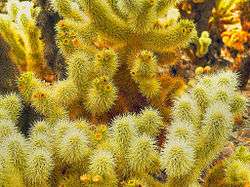
Many animals make their homes in Joshua Tree. Birds, lizards, and ground squirrels are most likely to be seen because they are largely active during the day. However, it is at night that desert animals come out to roam. Mostly nocturnal animals include: snakes, bighorn sheep, kangaroo rats, coyotes, and black-tailed jackrabbits.[18]
Animals that thrive in Joshua Tree often have special adaptations for dealing with limited water and high summer temperatures. The smaller mammals and all reptiles take refuge from the heat underground. Desert mammals make more efficient use of their bodies’ water supply than does the human body. Reptiles are physiologically adapted to getting along with little water, and birds can fly to water sources when they need to drink. Nevertheless, the springs and seeps in the park are necessary to the survival of many animals.[18]
Most of the reptiles and many small rodents and insects go into an inactive state of hibernation during the winter. However, winter is the time of greatest bird concentrations in the park, because of the presence of many migrant species.[18]
A good place to view wildlife is at Barker Dam, a short hike from a parking area near Hidden Valley. Desert bighorn sheep and mule deer sometimes stop by the dam for a drink. Tours of the Barker Dam area are available.
Wildlife of the park includes:
- The California tree frog, Pseudacris cadaverina, is found in the rocky, permanent water sources created by the Pinto Fault along the northern edge of the park.[19]
- The red-spotted toad, Bufo punctatus, is a true denizen of the desert, where it spends most of its life underground. Found from one end of the park to the other, it appears after good, soaking rains.[19]
- Golden eagles hunt in the park regularly.[20]
- The roadrunner is an easily recognized resident.[20]
- The call of Gambel's quail can frequently be heard.[20]
- The tarantula Aphonopelma iodium, the green darner Anax junius, and the giant desert scorpion Hadrurus arizonensis are arthropods that can grow to be more than 4 inches (10 cm) long.[21]
- The yucca moth Tegeticula paradoxa is responsible for pollinating the Joshua trees after which the park is named.[21]
Wilderness
Of the park's total land area of 790,636 acres (319,959 ha), 429,690 acres (173,890 ha) are designated wilderness and managed by the National Park Service (NPS) in accordance with the Wilderness Act. The NPS requires registration for overnight camping at specific locations called registration boards. Other requirements include the use of a camp stove as open campfires are prohibited and employing Leave No Trace camping techniques (also known as "pack it in, pack it out").[22] Although bicycles are not allowed in wilderness areas, horses are, but a permit must be obtained in advance for travel in the backcountry.


Vandalism
On April 1, 2015, graffiti artist André was convicted and fined for vandalizing ancient rock formations in the park.[23] André posted photos of his vandalizations on Instagram. The web site Modern Hiker and its readers aided the National Park Service in tracking down and identifying André's vandlaism.[24] Before the conviction, André attempted to silence the reporting with legal threats.[25]
In popular culture
In 1972, the album cover photos for Eagles were shot in Joshua Tree National Park.[26]
In 1973, Phil Kaufman attempted to cremate singer/songwriter Gram Parsons' remains here.[27] To this day, people continue to visit in tribute to Parsons.
In 1987, Irish rock band U2 released their fifth studio album The Joshua Tree.
In 1994, American Tejano singer Selena recorded her music video for "Amor Prohibido" at Joshua Tree National Park.[28]
In 2016, neo-hasidic hipster group Zusha recorded their music video in Joshua Tree National Park.
See also
- Cahuilla
- California Desert Protection Act of 1994
- Chemehuevi
- Johnny Lang
- Mojave and Colorado Deserts Biosphere Reserve
- National Register of Historic Places listings in Joshua Tree National Park
Notes
![]() This article incorporates public domain material from websites or documents of the National Park Service.
This article incorporates public domain material from websites or documents of the National Park Service.
- 1 2 "Listing of acreage as of December 31, 2013". Land Resource Division, National Park Service. Retrieved 16 March 2014.
- ↑ "NPS Annual Recreation Visits Report". National Park Service. Retrieved 16 March 2014.
- 1 2 "A Desert Park". Joshua Tree National Park, NPS. Retrieved 6 May 2009.
- ↑ Zarki, Joe. "A Park for Minerva". Joshua Tree National Park, NPS. Retrieved 17 December 2013.
- ↑ "Park History". Joshua Tree National Park, NPS. Retrieved 17 December 2013.
- ↑ "Operating Hours & Seasons". Joshua Tree National Park, NPS.
- ↑ Southern California Plant Communities 15. Joshua Tree woodland
- ↑ "Geologic Formations". Joshua Tree National Park. Retrieved 10 December 2013.
- ↑ Trent, D.D. (April 1984). "Geology of the Joshua Tree National Monument". California Geology. 37. Retrieved 10 December 2013.
- ↑ "Camping". Joshua Tree National Park, NPS. Retrieved 6 May 2009.
- ↑ "California Resort Life". CaliforniaResortLife.com.
- ↑ "Hiking". National Park Service. Retrieved 6 May 2009.
- ↑ "Graffiti Force Closure Of Joshua Tree Park Sites". AP. Retrieved 14 April 2013.
- ↑ "Geology Motor Tour". Joshua Tree National Park, NPS. Retrieved 6 May 2009.
- 1 2 "USGS Bird Checklist". Retrieved 20 June 2010.
- ↑ "Joshua Tree National Park: Stargazing". Joshua Tree National Park, NPS. Retrieved 15 August 2011.
- ↑ "ClearDarkSky Light Pollution Map". ClearDarkSky.com. Retrieved 18 August 2015.
- 1 2 3 "Animals". Joshua Tree National Park, NPS. Retrieved 20 January 2012.
- 1 2 "Amphibians". Joshua Tree National Park, NPS. Retrieved 20 January 2012.
- 1 2 3 "Birds". Joshua Tree National Park, NPS. Retrieved 20 January 2012.
- 1 2 "Insects, Spiders, Centipedes, Millipedes". Joshua Tree National Park, NPS. Retrieved 20 January 2012.
- ↑ "Backpacking". Joshua Tree National Park, NPS. Retrieved 6 May 2009.
- ↑ Spiers, Katherine (April 15, 2015) "Artist "Mr. Andre" Pays Fine For Vandalizing Joshua Tree National Park." KCET. org. (Retrieved 4-16-2015.)
- ↑ Schreiner, Casey (February 27, 2015). "Is Mr. Andre tagging in Joshua Tree?". Modern Hiker.
- ↑ Schreiner, Casey (March 10, 2015). "Mr. Andre issues legal threat to Modern Hiker". Modern Hiker.
- ↑ Simmons, Bill. "The Eagles' Greatest Hit". Grantland. Retrieved 2015-08-18.
- ↑ "What's up with the strange end of country-rock pioneer Gram Parsons?" from The Straight Dope
- ↑ Villarreal, Yezmen. "28 Things You Didn't Know About Selena". BuzzFeed. Retrieved 18 August 2015.
References
- Birds, Joshua Tree National Park Association
- Joshua Tree: the Complete Guide: Joshua Tree National Park ISBN 978-0-9825172-3-9
- "Joshua Tree" (2001), California's Gold. VHS videorecording by Huell Howser Productions, in association with KCET/Los Angeles. OCLC 655384402
- Zarki, Joseph W. (2015). Joshua Tree National Park. Mount Pleasant, SC: Arcadia Publishing (Images of America). ISBN 978-1-4671-3281-7.
External links
- Official website by the National Park Service
- Map of Joshua Tree National Park
- Geologic Travel Cuide: article by the American Geological Institute
- "Keys Ranch: Where Time Stood Still", a National Park Service Teaching with Historic Places (TwHP) lesson plan
- Joshua Tree National Park Bird Checklist with seasonal info.
- "Motorcycle Classics" Motorcycling through Joshua Tree National Park article
- U.S. Geological Survey Geographic Names Information System: Hidden Valley
-
 Geographic data related to Joshua Tree National Park at OpenStreetMap
Geographic data related to Joshua Tree National Park at OpenStreetMap
